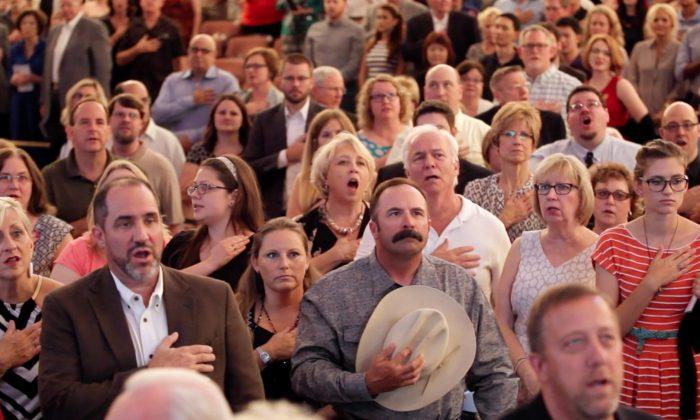FORT WORTH, Texas—On the evening of Sept. 11, 2001, the musicians of the Fort Worth Symphony Orchestra launched their concert with a piece that many of their symphonic compatriots nationwide were also playing that mournful week: “The Star-Spangled Banner.”
Unlike with most other orchestras, this wouldn’t be just a momentary musical bowing of the head, a single remembrance of a horrific day in American history. It became the start of a tradition.
Fourteen years later, the Fort Worth Symphony is one of the few major-city orchestras that play the national anthem before every full-orchestra performance.

The Fort Worth Star-Telegram reports that patrons know the ritual well: After the recorded “silence your cellphones” announcement, first the concertmaster and then the conductor walk onstage.
The conductor steps onto the podium and signals for a snare-drum roll. The orchestra members rise and begin to play—from memory—as the audience stands and faces the flag onstage. The singing by the music-loving audience is much better than at other public events. More often than not, a soprano can be heard lingering on the “free” high note near the end.

The orchestra takes the rhythmic piece at a good clip; the whole thing lasts about 90 seconds.
Recently, the routine inclusion of the national anthem has ruffled feathers, prompting the head of the orchestra to publicly defend the tradition.
A musician attending a concert at Bass Hall wrote a Facebook post Aug. 29 bemoaning the anthem’s automatic place at the top of the program, calling it “an outrage that the musicians of the excellent Fort Worth Symphony” must play it at every concert.
The post received enough supportive replies to compel the symphony’s president, Amy Adkins, to write a lengthy post on her Facebook page. The post has been added to the symphony’s page.

“It is a simple but poignant way that we can use music to honor those who serve or have served in the U.S. military, as well as those who have lost their lives,” she wrote. “Van Cliburn, Fort Worth’s most adored citizen and one of the greatest pianists of our time, began every recital with his own rousing rendition of the anthem.”
Her post drew dozens of supportive comments, some by notable composers and musicians in the classical music world.
“I had a long conversation with Yo-Yo Ma after the gala about a year and a half ago about arts being instrumental in creating social change,” Adkins elaborated in an interview. “The orchestra does that in many ways, but the performing of the national anthem is a symbol of that. In a small way, it’s creating a sense of unity.”
For Theodore Harvey, a cellist with the Dallas Symphony Orchestra who wrote the critical Facebook post, it’s an issue of place and mood.
“I don’t think orchestra concerts are meant to be nationalistic or patriotic events unless it’s a specifically patriotic program,” Harvey said in an interview, noting that he was speaking for himself, not the Dallas orchestra.
“When a conductor plans a program, he has a certain selection of music and a certain order in mind. The first piece that he picks is meant to set the mood. ... It’s very jarring for the people who are there just for the music.
“When I go to a concert of Haydn, Mozart and Beethoven, I want to be immersed in the world of 18th-, early-19th-century Austria, and ‘The Star-Spangled Banner’ manifestly does not fit with that.”
Harvey is not alone in his sentiments. Comments on his post ranged from “Why do we need to prove our patriotism at a concert? How many of those people sing but cannot be bothered to vote or read the paper?” to “As Dr. Johnson observed, patriotism is the last refuge of a scoundrel.”
Norman Lebrecht, the British commentator and author who runs Slipped Disc, a website devoted to classical music worldwide, didn’t comment on the post. But he understands the sentiment.
He said he doesn’t believe nationalistic anthems belong on every program. Similarly, he holds no nostalgia for the days when “God Save the Queen” was played in British movie theaters before the first and after the last screening.
“Times have changed. There was more pomp and circumstance about a live performance 50 years ago. Now it’s less formal. I prefer the informality,” Lebrecht, whose books include “Who Killed Classical Music?” and “The Life and Death of Classical Music,” wrote in an email.
“It’s a distraction. I go to a concert for art and elevation, not national service.”
While most American orchestras include the anthem sometime in the year—often for a season-opener or for pops, outdoor, and holiday-related concerts—it’s unclear how many perform it as regularly as the Fort Worth Symphony.
The League of American Orchestras, an umbrella group of about 800 North American orchestras, doesn’t keep track, but the organization’s media relations director, Rachelle Schlosser, said, “It is certainly a rare occurrence.”
One orchestra that can match Fort Worth’s is the Oklahoma City Philharmonic, which has played the anthem before nearly every performance since 1990. In fact, the OKC Phil’s marketing director, Susan Webb, said the orchestra began playing “The Star-Spangled Banner” regularly after audience members requested it with a signed petition.
More typical is the Dallas Symphony, which this season will play the anthem at the AT&T Gala on Sept. 26 and at each of the first set of concerts that launch the Texas Instruments Classical Series, taking place Oct. 1-4.
“We also might perform the anthem during special patriotic-themed concerts outdoors—the Patriotic Concert and Fireworks at Flag Pole Hill that we do annually on Memorial Day comes to mind,” DSO spokesman Chris Shull said.
Fort Worth visual artist J.T. Grant is glad the Fort Worth Symphony plays the song, which officially became the national anthem in 1931.
“If you look at the context of the time, the Depression was underway. Now, beginning with 9/11, there was a similar sense of having the floor pulled out from under us,” he said. “It’s played at football and baseball games, but it’s not a fight song. Its purpose is to unify us and take us out of the individual and remind us of what we’re capable of.”
He said he doesn’t believe the anthem spoils the mood any more than the talks a conductor might give before a performance.
“I’ve been to the symphony many times, and there’s been lots of laughter—some very loud laughter—and that does nothing to ruin the mood,” he said.
On Facebook, Grant responded with praise to Adkins’ online defense of playing the anthem. Adkins also had support from noted composer Jennifer Higdon, who wrote: “I have always loved the singing of the national anthem at FWSO concerts! And I’ve always been impressed by the enthusiasm and robustness of the audience’s participation.”
While Adkins said she has received the very occasional negative response to the anthem from a concertgoer, Harvey thinks that many others may feel the way he does.
“I know there are other people who don’t like it,” he said. “I remember a friend of mine, who absolutely loves Mahler ... was so excited to hear this Mahler symphony and she was absolutely shocked that the concert started with ‘The Star-Spangled Banner,’ which was totally not why she came there. It’s obviously a totally different mood than what is created by a Mahler symphony. It makes a concert something other than what a concert is supposed to be.”
Also, Harvey said, regular playing of the anthem might lessen its significance, even among the most patriotic audience members.
“Not everyone at every FWSO concert is American or identifies emotionally with American patriotism,” he said. “And even for those who are and do, it seems to me that doing it as a routine rather than just on special patriotic occasions cheapens it by making it less special.”
If anything, the FWSO will double down on its use of the anthem. Music director Miguel Harth-Bedoya said he would like to have contemporary composers come up with their own interpretations, through either a commission or a competition.
“At sports events, how many different versions of ‘The Star-Spangled Banner’ do we hear? All of them are improvised and none of them are written down,” he said. “The beauty of a symphony is that you can write things down.”







Friends Read Free